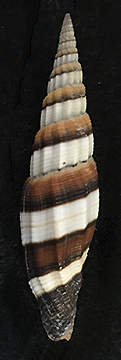SOME WILDFLOWERS ENCOUNTERED WHILE PROSPECTING FOR FOSSIL MOLLUSKS
It is always a pleasure when I encounter some beautiful wildflowers while prospecting for fossils. While doing field work in northern Los Angeles County in southern California, I have often hiked through localized areas where wildflowers are in bloom during late spring to early summer. One such example is on the north flank of the overturned (north-vergent) Pico Anticline of the Santa Susana Mountains. This anticline, which trends northwestwardly for approximately 9 miles (15 km) was an oil-producing structure between the 1840’s and the 1940’s.
Geologic cross section of the Pico Anticline, with the red spot indicating the patches of poppy/lunpine flowers (see below for images of the flowers). They grow on soil associated with a transitional sedimentary sequence consisting of interbedded mudstone/siltstone and fine sandstone within the lower Pliocene Miocene Towsley Formation. This area where the wildflowers are concentrated is on southeast-dipping beds that are nearly recumbent (overturned). It is likely the combination of a favorable elevation for rainfall (about 1900 feet above sea level), fine-grained soil for retaining moisture, and a south-eastwardly facing slope have created ideal conditions for the localized growth of these flowers.
THE CALIFORNIA POPPY
Family Papavaraceae [the poppy family]: about half of the 26 genera belonging this family are found in California.
Genus Eschschholzia: all of its species have bright yellow or orange flowers.
Comments: The fruit (= a capsule) is a source of heroin and morphine. The deep tap roots of this plant allows for the plants to persist for several seasons. This is California’s state flower (decreed in 1903).
Poppy field with some scattered lupines (purple).
Another poppy field with more lupines.
LUPINE
Family Gabaceae [the Pea family]. Second to sunflowers family, this is one of the largest families of plants.
Genus Lupinus: there are over 82 species found in California. The flowers range in color from blue to purple to white.
Comments: The genus name means “wolf,” because these plants rob the soil of its nutrients. Lupine is a benefical plant because it adds nitrogen to the soil through its root nodules. This plants, however, can also produce dangerous alkaloids contained primarily in their fruits.
Slope covered with lupines.
STICKY-LEAF MONKEY FLOWER
Family Scrophulariaceas [the figwort family].
Genus Mimulus: there are 150–175 species in California.
Comments: This wildflower is extremely widespread in North America. The herbage of this plants is “sticky,” hence its name.
An example of the sticky-leaf money flower shrub in the Pico
Anticline area.
MUGWART
Family Asteracea [the daisy family]
Genus Artemisia
Comments: This plant is widespread in the world, and there are 13 species. In southern California, it is found at elevations less than 6,000 feet. During the summer, this plant has small clusters of red/brown flowers with white bases (Wikipedia, 2024; diagram insert), but I have never seen any of them (I usually did my field in the Spring). Mugwart is an aromatic plant with a strong sage odor. The tops of its leaves are green, but the bottoms are gray.
Mugwart plants in the Pico Anticline area. The view about 1 foot in width.
A sketch (based on a Wikipedia image) showing mugwart flowers (red tops and white bases) (each flower about 1 inch long).
POISON OAK
Family Anacadiaceae [the sumac family]
Genus Toxicodendron
Contact with poison oak should be avoided at all costs, because it toxic plat can produce very itchy, red-colored sores on one's skin that can last for several days!
Poison oak (Toxicodenron diversilobum) occurs in California, Baja California, Nevada, Oregon, Washington, and British Columbia (Wikipedia).
Despite its name, it is not closely related to oaks, nor is it a true tree. Poison oak prefers to live on north-facing slopes. Its leaves are scalloped. In the spring, their leaves are green, but they turn red in late July to October.
Poison oak shrub, Pico Anticline area in July.
Close-up of poison oak leaves in the vicinity of the Pico Anticline in October. The tops of poison-oak leaves usually have a somewhat waxy appearance.
References:
Belzer, T.J. 1984. Roadside plants of southern California. Mountain Press Publishing Company, Missoula. 158 pp.
en.wikipedia.org 2004.



































